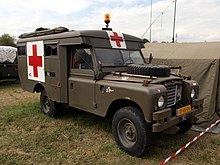
The Army Reserve is the active-duty volunteer reserve force of the British Army. It is separate from the Regular Reserve whose members are ex-Regular personnel who retain a statutory liability for service. The Army Reserve was known as the Territorial Force from 1908 to 1921, the Territorial Army (TA) from 1921 to 1967, the Territorial and Army Volunteer Reserve (TAVR) from 1967 to 1979, and again the Territorial Army (TA) from 1979 to 2014.
The 43rd Infantry Brigade was a brigade of the British Army during the First and Second World Wars, and later, as 43 (Wessex) Brigade, a regional headquarters from 1985 to 2014.
The Wessex Regiment was a Territorial Army infantry regiment of the British Army, in existence from 1967 to 1995. Initially consisting of a singular battalion, the regiment was later expanded to also have a second.
The Queen's Own Warwickshire and Worcestershire Yeomanry (QOWWY) was a regiment of the Royal Armoured Corps, forming part of the Territorial Army (TA). Following reductions in 1969 and 1971 respectively the regiment was reduced to two and later one company sized sub-unit in 1999. Following a reorganisation in 2021, there are now two successors to the regiment: one squadron in the Royal Yeomanry as light cavalry, and one squadron in the 37th Signal Regiment as a support squadron.

In the British Army and other Commonwealth militaries, a Casualty Clearing Station (CCS) is a military medical facility behind the front lines that is used to treat wounded soldiers. A CCS would usually be located just beyond the range of enemy artillery and often near transportation facilities. The CCS receives battlefield casualties from regimental aid posts located in the combat zone. Casualties that cannot be adequately treated in the CCS are stabilized there before being transported to a field hospital or military hospital.
The 1st Somersetshire Engineers was a volunteer unit of Britain's Royal Engineers (RE) whose history dated back to 1868. As the engineer component of the 43rd (Wessex) Division, the unit served in both World Wars, distinguishing itself at the assault crossing of the River Seine at Vernon in August 1944 and in the doomed attempt to relieve the 1st Airborne Division at Arnhem. A detachment also served as airborne engineers in Sicily, Italy and at Arnhem. Their successors served on in the Territorial Army until 1967.

The 6th Battalion, Hampshire Regiment was an infantry battalion of the British Army. Part of the Volunteer Force, later the Territorial Force, the battalion was part of the Hampshire Regiment and recruited from Portsmouth, Hampshire. It served as infantry during World War I and as a Royal Artillery regiment during and after World War II.
The following is a hierarchical outline for the structure of the British Army in 1989. The most authoritative source for this type of information available is Ministry of Defence, Master Order of Battle, and United Kingdom Land Forces, HQ UKLF, UKLF ORBAT Review Action Plan, HQ UKLF, 1990.
201 (Northern) Field Hospital was a unit of the Royal Army Medical Corps within the Army Reserve of the British Army.
202 (Midlands) Multi-Role Medical Regiment is a unit of the Royal Army Medical Corps within the Army Reserve of the British Army.

204 Field Hospital was a unit of the Royal Army Medical Corps within the Army Reserve of the British Army.

43 (Wessex) Signal Regiment was a Territorial Army (TA) unit of the British Army's Royal Corps of Signals from 1920. It had its origins in a Volunteer unit of the Royal Engineers formed in the West Country in 1860 and provided the communications for the 43rd (Wessex) Infantry Division during World War II. Its successor still serves as a squadron in today's Army Reserve.

The Exeter & South Devon Volunteers was the premier unit of Britain's Volunteer Force. Formed in 1852 it went on to become a battalion of the Devonshire Regiment. Both its active service battalions went to garrison India on the outbreak of the First World War, and then saw action in Mesopotamia and Palestine. In the Second World War, the battalion served in the garrison of Gibraltar. It continued in the postwar Territorial Army until it was merged with other West Country units. Its successors today serve in a reserve battalion of The Rifles.
205 (Scottish) Field Hospital was a unit of the Royal Army Medical Corps within the Army Reserve of the British Army.
207 (Manchester) Field Hospital was a unit of the Royal Army Medical Corps within the Army Reserve of the British Army.
208 (Liverpool) Field Hospital was a unit of the Royal Army Medical Corps within the Army Reserve of the British Army.
212 (Yorkshire) Field Hospital was a unit of the Royal Army Medical Corps within the Army Reserve of the British Army.
243rd (Wessex) Multi-Role Medical Regiment is a unit of the Royal Army Medical Corps within the Army Reserve of the British Army.

The National Reserve Headquarters, Royal Artillery is an Army Reserve administrative group of the Royal Artillery which oversees the recruitment and maintaining of specialist reserve units and personnel.

The 211 (Wessex) Field Hospital was a field hospital of the British Army forming part of the Royal Army Medical Corps. Formed in 1967 and disbanded in 1996, the hospital's remaining detachments continue to serve in its successor unit, the 243 Field Hospital.









